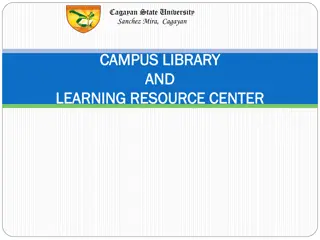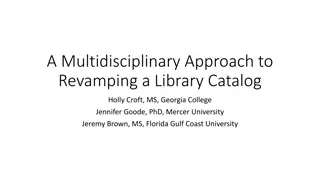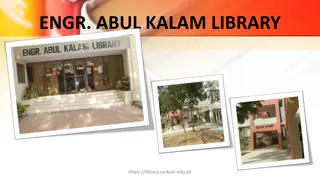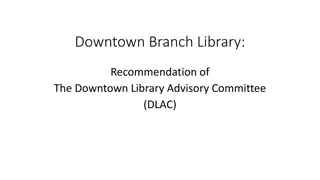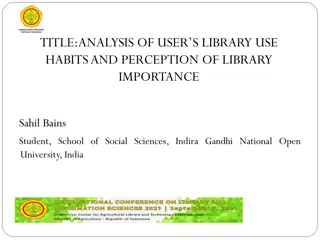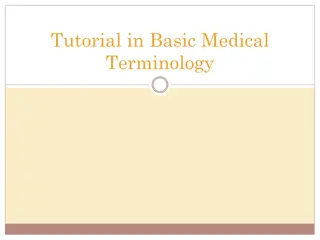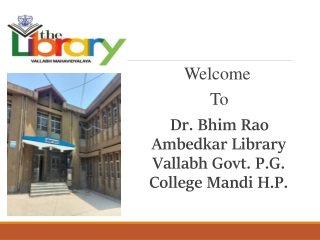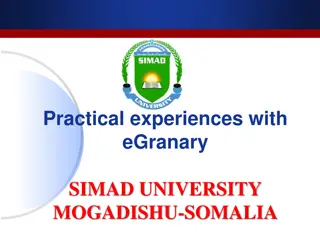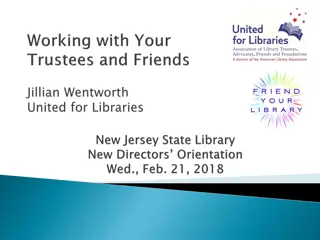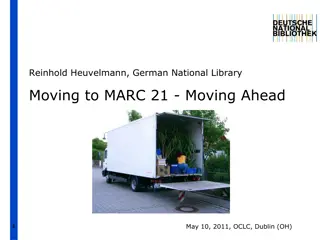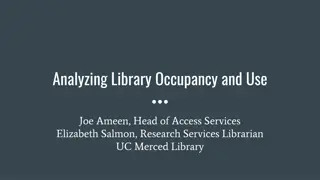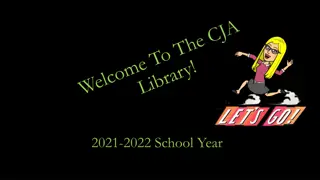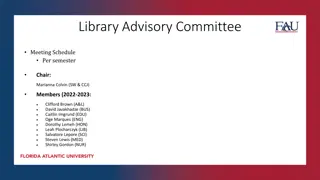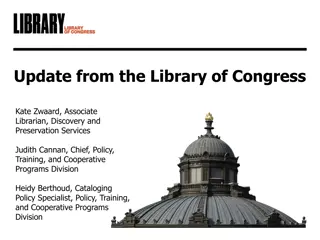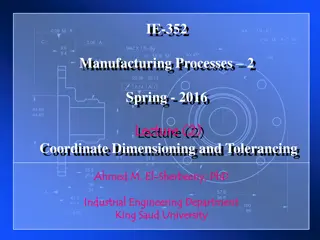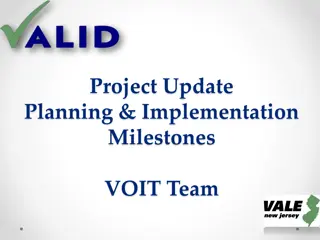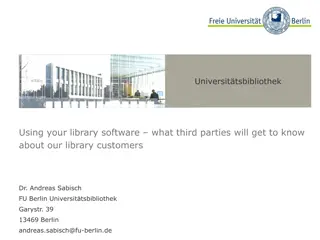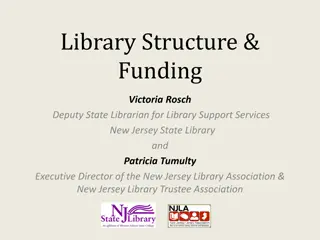Understanding Basic Terminology in Library Information Systems
Explore key terminology like Class, Entity, Superclass, Subclass, and more from the LRM Module. Learn about the definitions and relationships of these essential concepts in the context of library information systems.
Download Presentation

Please find below an Image/Link to download the presentation.
The content on the website is provided AS IS for your information and personal use only. It may not be sold, licensed, or shared on other websites without obtaining consent from the author. Download presentation by click this link. If you encounter any issues during the download, it is possible that the publisher has removed the file from their server.
E N D
Presentation Transcript
LRM Terminology LRM Module 2 Standing Committee on Training Program for Cooperative Cataloging (PCC) March 2020
Basic TerminologyOverview All definitions* taken from LRM Chapter 7, Glossary of Modelling Terminology Vocabulary mostly originates from the entity-relationship model Some vocabulary familiar from FRBR, but be cautious it may be somewhat differently defined * Except Inheritance 2
Terminology Covered in this Module Class Attribute Entity Relationship Superclass Inheritance Subclass Domain Disjointedness Range Property Reification 3
Class LRM gives no formal definition for class, although the term is used often Here are some definitions from common usage and from the RDF schema: A group, set, or kind, sharing common attributes (Merriam-Webster) Resources may be divided into groups called classes. The members of a class are known as members of the class (RDF Schema 1.1) The class concept is inherent to the enhanced entity-relationship model, but not part of a basic entity-relationship model 4
Entity An abstract class of conceptual objects, representing the key objects of interest in the model that is, the key objects of interest to users of library information systems. (LRM 4.1.1.) Entities are treated as classes in LRM; the term entity tends to be used mostly for the LRM entities, while class is used for non-RDA entities and descriptions of LRM entities. Other Modules will define and explain specific LRM entities. The primary benefit of treating entities as classes is that it also introduces the relational concepts of superclass and subclass 5
Class relationships--Superclass An entity may group several entities/classes together in a superordinate class, a more general class under which a set of more specific classes is incorporated. This is known in LRM as a superclass. AGENT (entity) Example: The entity Agent is the superclass of the entities Person and Collective Agent Is a superclass of COLLECTIVE AGENT (entity) PERSON (entity) 6
Class relationships--Subclass Multiple entities may be grouped into a superordinate entity, if all their instances are instances of that larger entity. This is known as a subclass. The LRM definition is: An entity, all of whose instances are also instances of a larger, superordinate entity. The relationship is described as an isA relationship AGENT (entity) Example: Is a subclass of The entities Person (an individual) and Collective Agent (a group) are subclasses of the entity Agent. COLLECTIVE AGENT (entity) PERSON (entity) Person isA Agent Collective Agent isA Agent 7
Entity Hierarchy: Superclass, Class, Subclass (IFLA Library Reference Model, August 2017, as amended and corrected through December 2017 (IFLA LRM (2017-12)) 8
Disjoint Entities Entirely non-overlapping sets. Disjoint entities can have no instance that is simultaneously an instance of more than one of these entities IFLA LRM declares that, other than those entities related by the isA hierarchies, the entities in the model are disjoint. (IFLA LRM (2017-12) 5.2) ENTITY A ENTITY B IS DISJOINT WITH 9
Disjointness is easy! Some examples of disjointness are easily understandable. For example, something cannot be both an instance of the person entity and an instance of the collective agent entity. COLLECTIVE AGENT (entity) PERSON (entity) IS DISJOINT WITH (cannot be a) These entities have an isA relationship to the entity agent, but they are disjoint to each other. 10
Maybe not always easy. Disjointness is less obvious but equally important when something is considered in different aspects. NOMEN STRING: HAMLET ITEM (entity) WORK (entity) EXPRESSION (entity) MANIFESTATION (entity) IS DISJOINT WITH IS DISJOINT WITH IS DISJOINT WITH For example: Hamlet as work, expression, manifestation, and item: all may share the same nomen string (can be referred to by the same name) but are nonetheless different and disjoint entities 11
Property, Attribute, Relationship Property: An attribute or relationship of an entity Category attribute: Novel Representative Expression attribute: English WORK (entity) Attribute: A type of data which characterizes specific instances of an entity TIME-SPAN (entity) BOOK (entity) Relationship: WAS PUBLISHED A connection between instances of entities Attributes and Relationships are discussed more fully in subsequent modules. 12
Inheritance Definition: Modeling in which an entity or class automatically acquires all the attributes and relationships from its superclass. Example: The Agent entity has the following attributes: Contact information [LRM-E6-A1] Field of activity [LRM-E6-A2] Language [LRM-E6-A3] The Person entity inherits these attributes and adds the following attribute: Profession/Occupation [LRM-E7-A1] 13
Properties--Inheritance Any property (relationship or attribute) that applies to a superclass also applies to all entities of its subclasses Example: Any relationship or attribute that applies to the entity Agent also applies to the entity Person (a subclass of Agent), and therefore does not need to be specifically declared for Person The entity Agent has the attribute Language, defined as A language used by the agent when creating an expression. The entity Person is a subclass of the entity Agent and therefore also has the attribute Language The relationship is member of is defined for the entity Agent. It also applies to the entity Person, which is a subclass of the entity Agent 14
Relationships--Domain & Range Domain: The source entity, or departure point, for a relationship Range: The target entity, or arrival point, for a relationship To use a grammatical analogy, Domain and Range can be thought of as the subject and object, respectively, of a relationship. DOMAIN (SUBJECT) RELATIONSHIP (VERB) RANGE (OBJECT) 15
Domain & Range For example: In the relationship Work is realized through Expression, Work is the domain and Expression is the range. WORK (DOMAIN) EXPRESSION (RANGE) IS REALIZED THROUGH In the inverse relationship Expression realizes Work, Expression is the domain and Work is the range. EXPRESSION (DOMAIN) WORK (RANGE) REALIZES Domain and Range are revisited in later modules 16
Reification Process through which a relationship is modelled as an entity, so that it can in turn have its own attributes and relationships In non-technical English, to reify is To regard or treat (an abstraction) as if it had concrete or material existence. [Latin r s, r -, thing + fy.] (American Heritage Dictionary, third edition.) Reification in LRM is just a specialized instance of this. Relationships are not entities in LRM, but treating them as if they were allows them to be more fully described and discussed (as in Table 4.7 and the detailed definition in 4.3.3). Reification is further discussed in later modules 17


